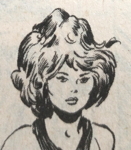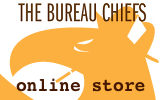You are currently browsing the marvel category
So there’s been some discourse online about editorial denial about specific events/characterizations both explicit and otherwise heavily implied in recent X-Men comics, specifically regarding Jean Grey, Wolverine, and Cyclops. I haven’t read an X-book in probably a decade-and-a-half, so I can’t speak to specifics, but it’s pretty clear the creative teams had one intention with the characters’ particular romantic triangle, and the highers-up are giving the ol’ “noooope” to the whole deal.
This put me in mind of other editorial decrees that seemed…oiut of place to me. This was a discussion on Bluesky, which started with my post here, and I fully acknowledge the contributions others made there with their replies in informing my blog entry here.
I’m going to address the second example I gave there first, in that it’s stated that the Hulk has never purposefully killed. Okay, I don’t know for sure that this was an editorial demand, but here in Incredible Hulk #110 (November 2007) by Greg Pak, Carlo Pagulayan and Jeffrey Huet, Hulk’s Really Smart Pal Amadeus Cho explains what’s going on:

He continues:
“How many times have you fought the military? How many tanks and helicopters have you smashed?
“And not a single soldier has died.
“Yesterday you brought down the Sentry’s Eyrie. You smashed the top of the Baxter Building.
“You pulverized all these heroes…
“…And yet you haven’t killed a single soul.”
Hulk brings up some examples where he has killed, but Cho counters these were instances of self-defense against other killers, as opposed to slaughter of innocents during mindless rampages. Basically, so long as the normal Bruce Banner/Hulk dynamic is in place, Banner is somehow running numbers/probabilities in the background, exerting some subtle influence to prevent Hulk from murdering people.
There is the caveat that Cho slips in there about “as long as your brain hasn’t been tampered with,” allowing for an “out” for examples of Hulk killing, like, say, during instances of Banner being entirely subsumed by the Hulk’s personality, or removed entirely.
This is all fine with me, to be honest. It feels counterintuitive, that there were no casualties during one of Hulk’s destructive rampages, but This Is Superhero Comics. This isn’t any worse or stranger than super-battles always demolishing abandoned buildings, for example, or like the Flash clearing the area of civilians before the rest of the Justice League fights the Shaggy Man or whatever. It’s not as much fun if you realize thousands of people got slaughtered because the Avengers didn’t get to the scene on time.
For some reason this puts me in mind of the events from Miracleman #15 (the Eclipse Comics numbering, from 1988) by Alan Moore and John Totleben. This is like the exact opposite of the “thank goodness these buildings are empty!” kind of explanation for why every superhero battle isn’t the equivalent of multiple 9/11s. In this issue, Miracleman has his final(?) battle with former sidekick-turned-evil Kid Miracleman, and it’s just mayhem and slaughter all over the place, and it’s not all done by the bad guy:

It works here in context because the superbeings have been presented as above normal human concerns, uncaring about mortal lives, and that when these “gods” battle it’s humanity that pays the price. It’s a theme of the book.
The theme of the Hulk is “man vs. himself,” Banner having to cope with the monster that lives within in. The additional guilt of “and that monster kills a lot of people” would have made it an entirely different book.
Another thing this all brings to mind is Wolverine, where, as I recall, an edict was put down by then editor-in-chief Jim Shooter that the ol’ Canucklehead has never killed anyone. You know, despite this happening in X-Men #133 (May 1980) by Chris Claremont, John Byrne and Terry Austin:

…which was later retroactively explained that these guys Wolverine was fighting were just “injured” and came back as cyborgs or whatnot. Look, I’m not a big X-Men reader, I don’t know the details, but this clearly is a case of obvious intent being subverted by editorial edict. I mean, I get it, the X-Men are heroes, you don’t want ’em killing folks left and right, but this was clearly to show how dangerous Wolverine could be when not kept in check. It’s characterization, it’s a plot element adding tension to the proceedings. It’s a reminder that he’s not just a tough-talking bloke that hangs out at the X-Mansion, he is literally One Savage Dude.
Anyway, you can get into a whole thing just on X-Men comics alone. Jean Grey had to die because as Dark Phoenix she killed millions of beings, that sort of business. She got better, obviously, and I’m pretty sure they’re less shy about letting Wolvie off baddies now.
Should note that Amadeus Cho, in that Incredible Hulk #110 I excerpted above, goes on to tell Hulk that Captain America probably killed a few Nazis during WWII, because, well, it was WWII. Hate to tell you this Mr. Cho, but Cap did a little more than that:

I mean, holy crap. Though to be fair, maybe Bucky did ’em all in.
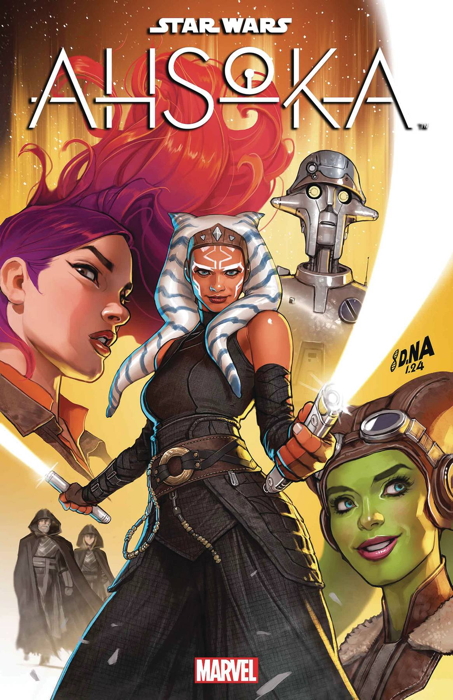
So I spotted on the back of the newest Marvel Previews an add for the forthcoming Star Wars comic book Ahsoka, starring the character who came to prominence in animation and recently jumped into live action portrayed by Rosario Dawson. A “fan-favorite” in the classic sense, as folks do seem to genuinely like the character, and at least at my shop toys and comics based on her usually do quite well.
The text of the ad reads “Ahsoka Tano gets her her own miniseries adaptation” and I groaned a little bit, as I realized it’s not new stories, but comic book retellings of the story from the recent Disney+ TV show. Now my immediate response was of course mature and reasoned…posting a meme to Bluesky:
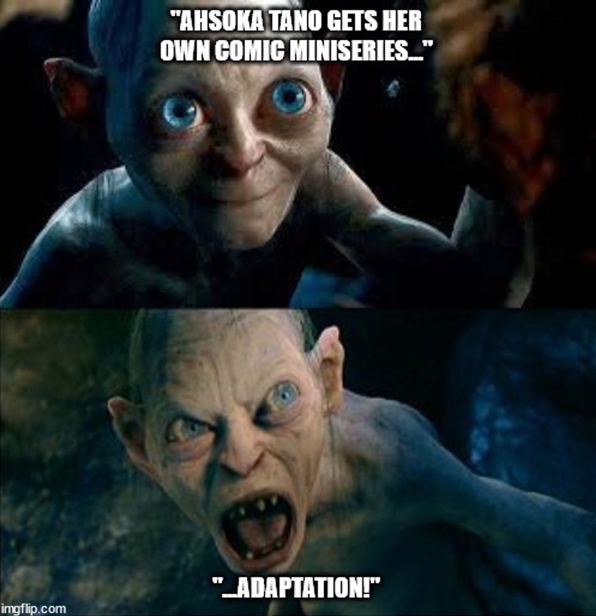
…and informing said response was the rather lackluster response I’ve had at the shop to other recent Star Wars comic book adaptations of other media. The recent Obi-Wan barely sells for me, I’ve had folks drop Thrawn because it’s adapting a novel, even The Mandalorian, the strongest selling of the bunch, has begun to flag. I’ve had multiple folks express their disappointment that they were just getting retellings of stories they’ve already enjoyed.
Way back in Ye Olden Tymes, before VCRs and various forms of disc players, a comic book adaptation of a movie was one of the few ways to relive the experience at your convenience. And TV shows…well, there weren’t many direct adaptations of TV episodes in comics, mostly focusing on new stories, but it was still a way to relive a program outside of its normal broadcast times, back in the days before you could pick up (or download) complete season sets.
While some of these were…utilitarian, shall we say, several did have some artistic merit and were completely enjoyable on their own terms. I still think Marvel’s Time Bandits comic is a classic, for example, and I enjoy looking at it even though I have the Criterion Blu-ray of the film just on the shelf over there. Evan Dorkin’s version of Bill and Ted’s Bogus Journey is another great movie-to-comic translation, with Dorkin’s wild cartooning creating an adaptation that arguably surpasses the source material.
Archie Goodwin and Walt Simonson’s Close Encounters of the Third Kind and Alien. Hook, featuring work by Charles Vess and Gray Morrow, among many others. The absolute infamous madness of the adaptation of Steven Spielberg’s 1941 by Steve Bissette and Rick Veitch. The beautiful Jerry Ordway art on the comic for the first Tim Burton Batman film.
I could keep going. I have a soft spot for many of the Star Trek movie comics DC produced (even with the occasional storytelling glitch).
But in this modern age, where everything is just a click away (legally or otherwise), the desire to relive cinematic experiences in funnybook form just isn’t there like it used to be. Even doing new stories based on films and TV isn’t quite the draw it used to be…but it seems for folks attracted to certain properties, if they had a choice, they’d want their comics to be new material rather than rehashing stories they’ve already experienced.
I’m not saying there isn’t an audience now for comics like Obi-Wan and Ahsoka. In fact, I expect Ahsoka #1 to sell quite well, just by virtue of being a Big First Issue for the popular character. I’m expecting a big dropoff on #2, however, as readers realize it’s just stories from the TV show, and as speculators stick with thier #1s and eschew later installments.
In addition, there will be the folks who don’t care it’s an adaptation, and want to enjoy a comic book version of the show. And there’s the simple fact that not everyone has Disney+, and this is their access to these particular adventures.
Now, I realize Marvel may have its hands tied in regards to what they can and can’t do with their licensed properties. I have no idea. All I know is the majority of my customers, when they hear “adaptation,” decide the comic is not for them, no matter how expertly it is artistically executed. While I’ll still sell copies, the number I’ll sell has been capped off.
I really do wish the. best for the creative team on this new Ahsoka comic. I hope it does well, not just for their sakes, but for my own store as well. Selling more comics is preferable to selling fewer, after all. And if Ahsoka does well, enough, maybe a follow-up with all-new stories will be in the offing. One can only hope.
Bryan says in response to my assertion that Venom made his first “on-panel” appearance in Amazing Spider-Man #300:
“I’m too lazy to go look, but doesn’t ASM 299 end with a splash page of Venom?”
Bryan is indeed correct, and in issue #298 we get this bit of business at the end of the issue:
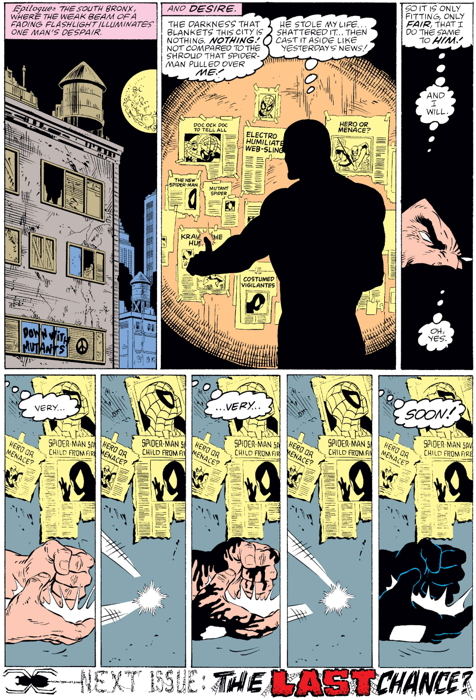
…and then in #299 we get this page and a half leading directly into the shocking events of the extra-sized next issue:
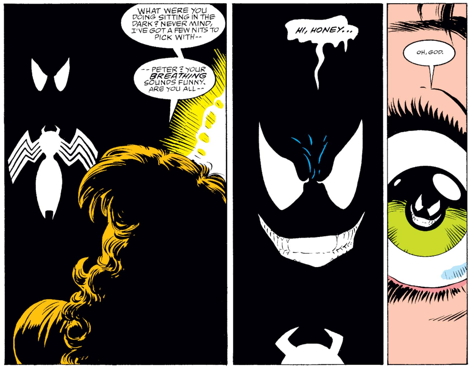
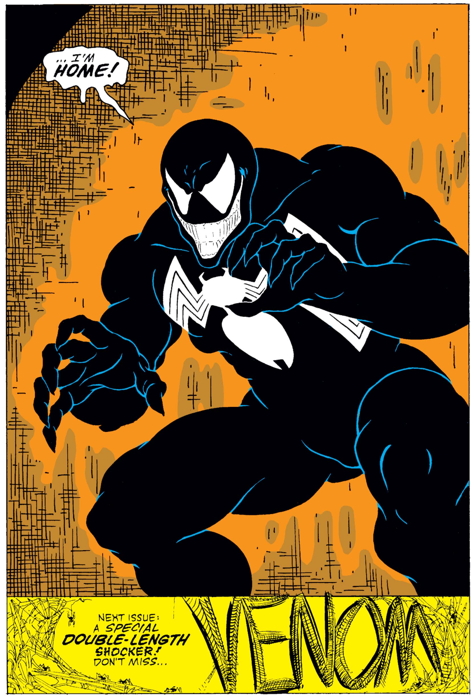
Now to be honest, in my mind I’d remembered Venom’s pre-300 appearance as being restricted to his face popping up in the bottom-of-the-page next issue blurb. I’d forgotten that his cameos in these previous two issues amounted to quite this much.
The Overstreet Price Guide refers to #298 as “1st app. Eddie Brock who becomes Venom, #299 notes “1st brief app. Venom with costume,” and #300 gets “1st full Venom app.” I mean, I guess getting Venom’s gloves in #298 isn’t enough for the “1st in costume” honor, but you can kinda see what sort of splitting of hairs is going on here. To be entirely strict about it, #299 should get the “first Venom” since it’s our first look at him in toto. But #300 is an anniversary issue, and it has that striking cover, and yes it is a full issue featuring Venom in action, and thus it’s the one that gets the most attention from collectors.
There’s precedent, of course, with Wolverine’s first appearances in Incredible Hulk issues in 1974. Issue #180 is the actual first appearance, with the ol’ Canucklehead popping up on the last page in this two-panel sequence:
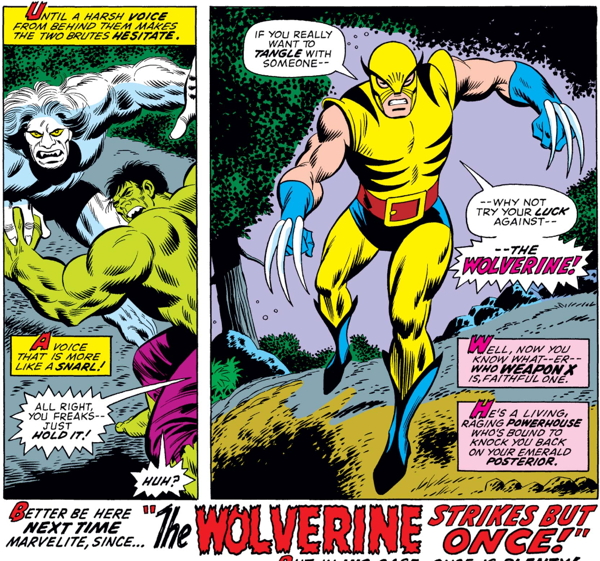
But again, #181 was the full-length in-story appearance of Wolvie, and had a kick-ass cover showing him in action, thus making this the most in-demand issue of the run. (Wolverine also appears in the opening pages of #182, and as we all know, was never seen again.)
So, yes, my statement of “first on-panel appearance” for Venom was incorrect, as he clearly shows up “on-panel” prior to #300. But like I said, I thought his only visual representation was in a blurb, not in-story, so I genuinely remembered #300 as The First One. And as far as collectibility and value goes, #300 is the most important one selling for many times the cost of the other two comics, with “first full issue appearance” and “first full appearance” being usually just shortened to “first apperance.” And those other two comics are generally just “cameo appearances” as far as the back issue market goes.
And the people pushing the house ads for Incredible Hulk #181 that were in earlier Marvel comics as the actual first appearance? GET OUTTA HERE WITH THAT NONSENSE
So last time we were talking about that scene in Fantastic Four #274 (1985), in which the alien symbiote that had been Spider-Man’s costume is freed from the lab where it had been contained. Here is a better look at the page in question (as drawn by John Byrne, Al Gordon and apparently Dan Adkins):
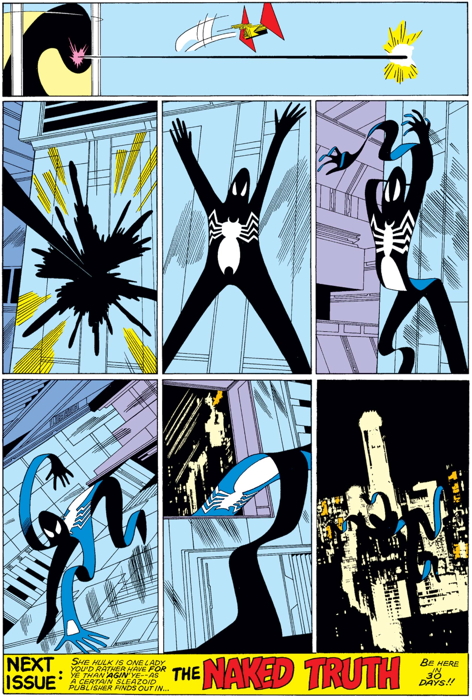
It was brought up in the comments that it was a little weird that this important moment in Spider-Man’s history happens in a Fantastic Four comic, but commenter “S” reminds us that the scene did appear in Amazing Spider-Man #261 (February 1985) by Tom Defalco, Ron Frenz and Joe Rubinstein:
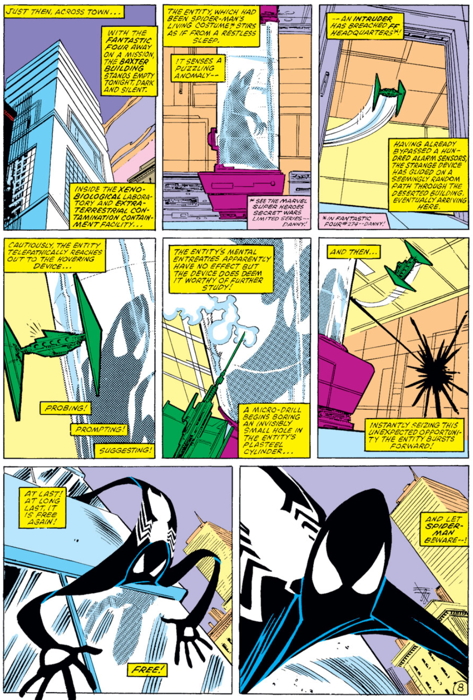
Slightly embarrassing in that I read this Spider-Man comic and should have remembered, though I think I can be forgiven since it’s probably been close to forty years since I’ve done so.
S also mentions this drone incursion was possibly sent by the Kristoff version of Doctor Doom (remember that period?), which is confirmed by this panel from Fantastic Four #278 (May 1985) by Byrne and Jerry Ordway:

As we see in the Spider-Man page, “Doom’s” plan didn’t explicitly involve “freeing the alien symbiote,” but somehow that critter managed to attract the probe into investigating further. Hence, the release of the symbiote putting it well on its way to Venom-ness, and leading into the release just a couple of months later of Web of Spider-Man #1, where said symbiote plays a part.
So there you go. Hopefully these couple of posts sucked all the Venom out of my blood and it’s no longer in my system, and I can finally move on to different topics. Like the Spider-Man villain Carnage, I could probably do a couple of weeks on him.
Just been a week for surprise comics news, I guess, as Marvel has finally announced that they’ll be doing an Uncle Scrooge McDuck comic: Uncle Scrooge and the Infinity Dime. Multiple covers, natch, with the “main” cover as such:
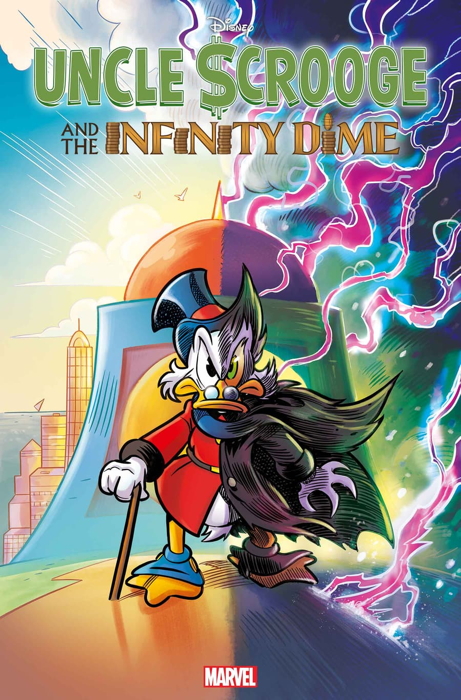
…and feast your eyes on the Alex Ross variant cover:
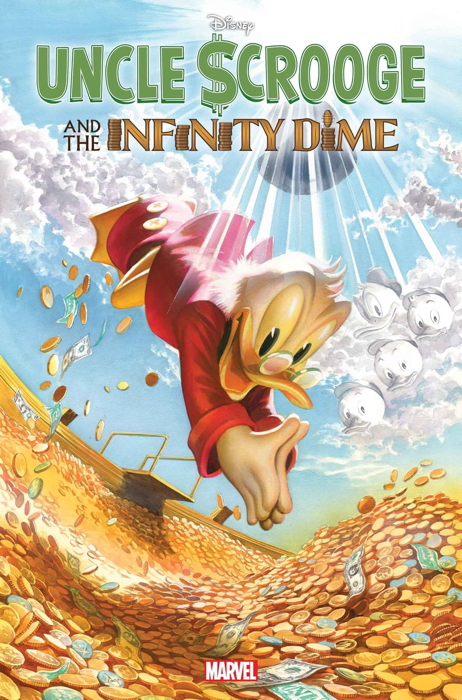
Now, if you read the description of the comic at the link, it certainly sounds like the most Marvel-type comic they could be doing with this Disney property. Is there a multiverse involved? Of course there is.
Speaking with a pal of mine, he asked “just who is the audience for this?” And ideally it should be children, and at my shop I get enough children passing through that children’s comics are a viable product line for me. I know this may not be the case at some shops, either by accident or design, but I think overall the target audience for this book may not getting exposed to it.
However, ain’t nuthin’ wrong with getting some of those Marvel readers to try out Uncle Scrooge too, either through some of that DuckTales nostalgia, or the fact that it’s being written by noted comics scribe Jason Aaron, or that Alex Ross cover, or that it’s being sold as a (quoting from the press release) “time-honored Marvel adventure,” and so on. Just getting the big push from Marvel may get more people to try it out aside from the usual Disney fans.
It looks like it’ll be fun, and. it’ll be a welcome return of Scrooge and Donald and the nephews to comic book stands. I hope it’s successful enough to generate follow-up comics, and that it creates new fans, especially young ones, for Disney comics.
I’ve seen several comments online hoping this means actual team-ups between Marvel’s heroes and the Disney gang. I would prefer this wouldn’t happen, but I can’t deny that they’d likely sell well until Marvel does too many of them. But I’ll tell you what, Donald Duck Vs. Howard the Duck: Battle for The Pants — Marvel/Disney, I would write that for (almost) free.
And the comics retailer in me has a wish or two of his own, like trade editions of Marvel’s previous forays into adapting Disney’s animation, like their Aladdin or Beauty and the Beast series. Or Marvel’s two Roger Rabbit graphic novels…people still like Roger Rabbit, they’d sell!
• • •
In even yet more news,
DC Comics is returning to Wednesday on-sale dates for their new comics, starting this July. Just as well, since hardly anyone noticed the change to Tuesdays in the first place. I mean, there were a few early birds, but otherwise folks just waited ’til Wednesdays.
DC should do their own version of these Marvel variants from around the time DC originally made the move in 2020.
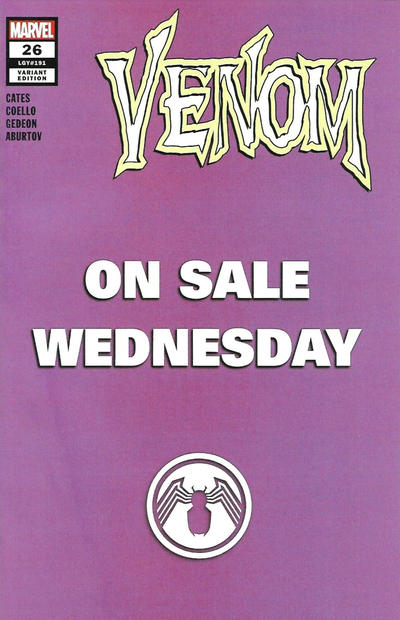
“DCs Back on Sale Wednesdays!” variants would be all the rage, I just know it.
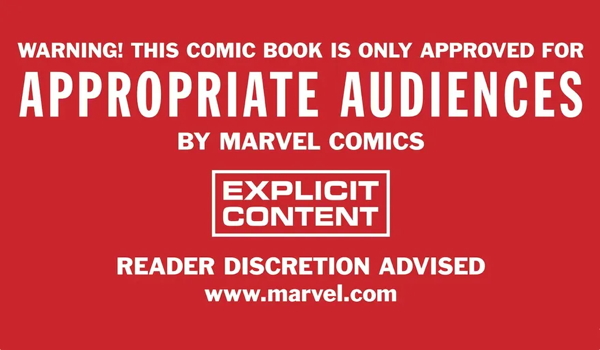
Well, this is certainly something.
I know, I’m a little late to this polybag party, but boy howdy what a weirdly pandering idea that’s only going to contribute to the idea that kids aren’t welcome to modern superhero comics. Which is okay, I guess, because kids got their own stuff goin’ on, and aren’t likely to be interested in Marvels outside of Miles Morales and Deadpool anyway.
Basically, Marvel has announced that they’ll be releasing a comic, Blood Hunt #1, where apparently you won’t have to hunt far for that blood as a “Mature Readers” version of the title with all the gore and violence you crave will be presented in an unexpurgated fashion. Meanwhile, they’ll also produce a censored “general audiences” version of the same book that won’t sell. The naughty version, naturally selling for a buck more than its bowdlerized counterpart, will be sealed in a polybag for that extra attention from parents who already think superhero comics are all too violent for their kids anyway.
Perhaps I sound a little annoyed at this.
Now chances are pretty good this series will go over like a thing that doesn’t go over very well, and the whole “pay that extra buck, see what the butler saw” gimmick will drop off the face of the direct market. Or everyone will decide “I don’t want the stupid version made for babies, gimme that explicit content” and it’ll sell like gangbusters and suddenly every Marvel comic has a polybag. (Then Marvel can push the “pure and innocent” unbagged variants and charge more for those.)
I was put in mind of Marvel’s publishing…let’s say “strategy” in regards to their initial attempt at doing Miracleman. In this post (and please excuse my optimism that new stories were “close”), I noted that they were polybagging Miracleman issues despite the content usually not warranting it. My assumption was that 1) it was a mature readers book under the Marvel logo, and thus should be hidden from theoretically innocent eyes, and 2) by polybagging every issue, when they got to the “birth” issue it wouldn’t stand out as the only polybagged one.
And also there’s 3) the hoped-for sales boost by providing the lure of the forbidden by sealing the contents away, which didn’t work and sales continued to plummet because nobody cared.
There is a chance this may not be the case with Marvel books, though, particularly ones set in the mainstream Marvel universe, under the Marvel banner, in a standard comic book format, and not shoved under some distancing mature-reader label like “MAX” or “Epic” or “Star.” (Yes, Star, that Heathcliff was a freak.)
As I said above, the main problem with this is the perception from parents in my shop that all superhero comics are “violent” and “gory.” I always try to tell them “there are plenty of kid-friendly superhero books.” But seeing this on the stands…well, okay, it’s just the one so far, but it’ll be more of a problem once Marvel starts cranking out more of them. Or, to be honest, folks tend to home right in on the very thing you’d prefer they didn’t notice, trust me on this. But this isn’t going to help dissuade the notion that superhero comics are scary and gross. (I mean, sure, some are, but not all of them!)
Also I’m being reminded of another time publishers tried this sort of thing, when Aircel offered “adults only” and “general audiences” versions of Barry Blair’s Leather and Lace. As I said there, given the overall look ‘n’ feel of even the supposed general audiences version, there was no way in hell I was going to sell that to kids. I’m hoping history doesn’t repeat itself with this newest iteration of the gimmick.
So in response to my post about the passing of Keith Giffen, LouReedRichards brings up a title that I’m sort of shocked at myself for not remembering. On one hand, I couldn’t list everything, but on the other hand, I really should have pointed out this comic from 1987:
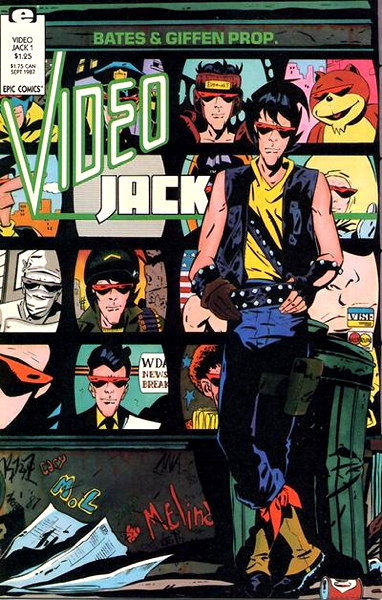
And here’s a sample page from the first issue:
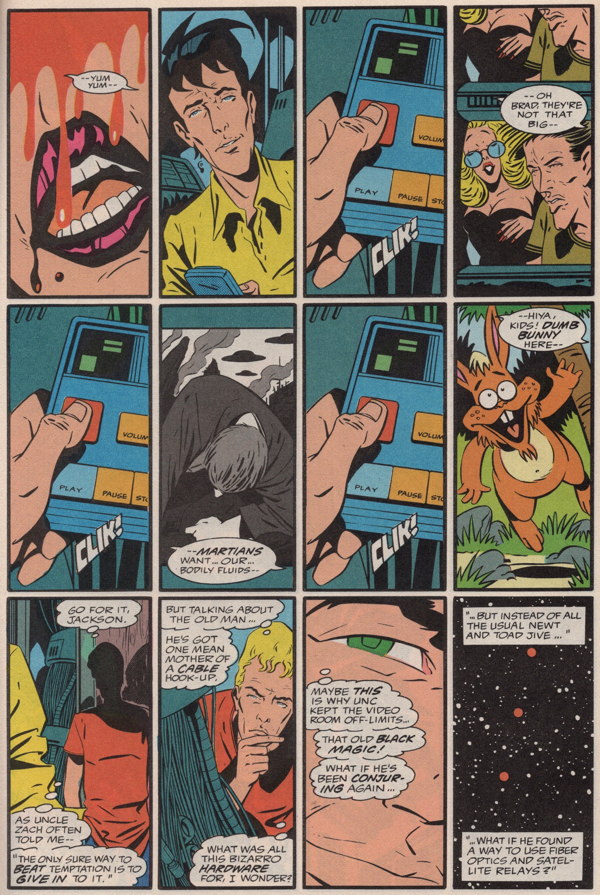
Did ol’ Keith do 12-panel pages throughout the series? Oh he sure does, for the most part, with some smatterings of six and nine panel pages, so this is one series dense with storytelling. Even the last issue, featuring several guest artists (like Fred Hembeck! Walt Simonson! Trina Robbins! Jim Starlin!) is mostly 6 or 9 panel grids. There’s the occasional breaking of the format, including a pretty stunning two-page spread in the first issue.
So here’s the thing about this comic.
I remember really looking forward to it. I even picked up one of the promo posters at the comic shop, where they had a stack they were giving away, and had it put up at home. And I bought each issue off the stands as it came out, its release coinciding with my beginning months of college.
And I’m pretty sure that was the one time I read it. Well, okay, I probably reread the whole series once it was complete. And it’s been 35+ years and I remember very, very little of it. As I flipped through my copies, extracted from what remains of the Vast Comics Archive, I remembered bits here and there, some of the conceits of the series, the character designs, etc. But there is a lot going on and I’m sure there are plenty of details I’m forgetting.
Hell, I even forgot that this was written by former DC Comics stalwart Cary Bates.
I remember really liking the series. But I couldn’t tell you really anything substantial about it, beyond “dude falls into a TV world” and I’m not even sure that’s 100% correct. But glancing through it, it’s definitely a showcase for this era of Giffen’s art. I definitely would love to be able to reread it, but “rereading older comics” is on the backburner while I’m still trying to catch up with the new stuff. As I posted on Bluesky:
“Well, if I’m going to reread every book and comic I’ve bought and kept over the last five decades, I’d better get started.”
In some cases, it may be just enough to remember that you liked a think, even if it no longer lives in your memory and you don’t have time to revisit. Ah well.
And it took three and half decades, but I finally get the punny joke of the title. …No one’s ever accused me of being too on the ball. Do I need to tell the Ms. Tree story again?
From The Comic Reader #163 (December 1978):
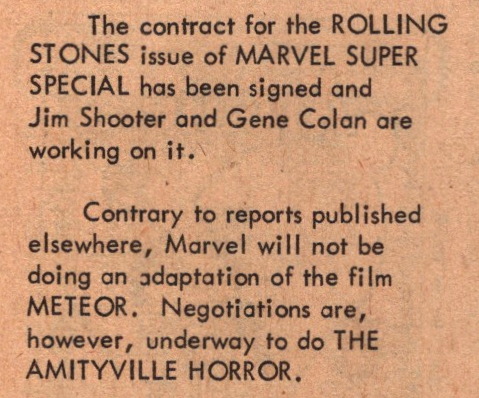
Not released: that specific Rolling Stones project and any Marvel-branded Amityville Horror book.
Definitely released: the Meteor adaptation in Marvel Comics Super Special:
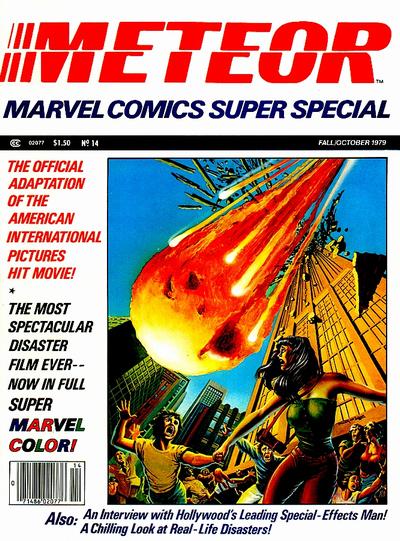
Now Marvel did eventually release a Rolling Stone comic, Voodoo Lounge by Dave McKean(!) so there’s that. And the band also shows up in an issue of What If.
But Amityville Horror, best to my knowledge, went nowhere at Marvel, except maybe providing some inspiration for other horror stories. But honestly, if Gene Colan was going to draw any of these things, it should have been this one. His nice moody, spooky art could’ve made something out of that haunted house tale.
Okay, you characters in the comments from Wednesday’s post got all Void Indigo on me, so I thought I’d look into that situation a bit further.
Void Indigo was a graphic novel and short-lived comic series by Steve Gerber and Val Mayerick, released in the mid-1980s under Marvel’s Epic imprint of mostly creator-owned material. Here’s what the cover to the initial installment, released in sequence in Marvel’s graphic novel line between Rick Veitch’s Heartburst and…Dazzler: The Movie?
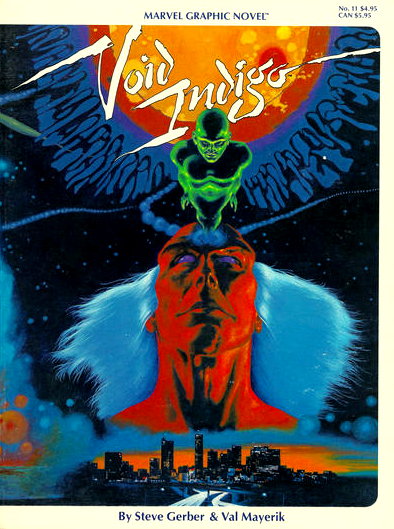
It made…quite the stir when it was released, for its violent content, upon which I cannot report as Void Indigo remains a blind spot in my Gerber reading. And due to its truncated nature, I never sought it out, since I figured “it never finished, why bother?” But one shouldn’t be so cavalier about dismissing a Steve Gerber script, especially since we’re not getting any more, so someday I’ll get my hands on these and check them out myself.
My expectation is that, by modern standards, the “shocking” content will be less shocking to current eyes (as noted in one of the responses to Wednesday’s post), but I would like to see it myself.
Since I had my 1980s Comics Journals out, I flipped through to see if I could find their article on the whole situation, and lo, there it was, in #95 (February 1995). Here I have a scan of the just the first part of the article, as it goes on for another half-page:
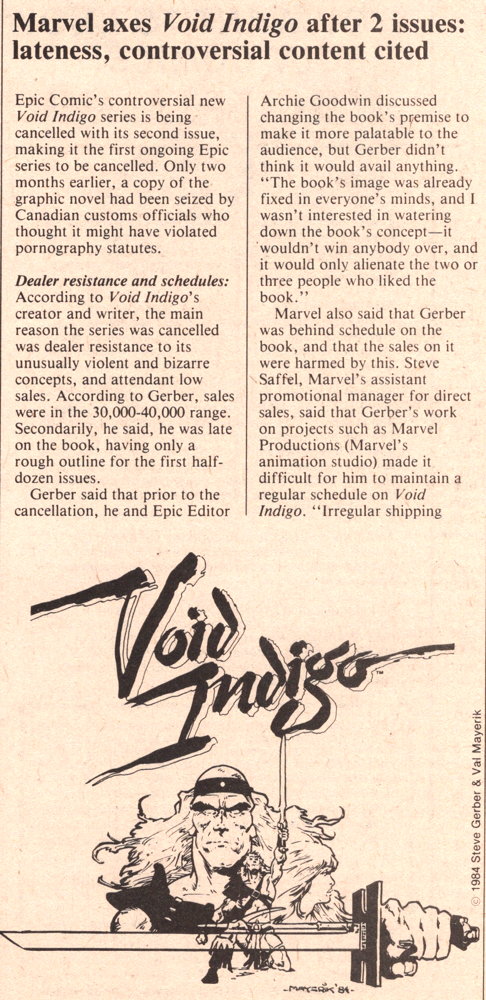
Apparently lateness was being pushed as much of a reason for cancellation as whatever horrible, soul-searing content within the comics themselves. Low sales at would-be-a-huge-hit-today numbers were also a problem. The article mentions later that the customs seizure basically amounted to nothing, as with the book’s cancellation the problem had solved itself.
There’s also a note in the article about Marvel not taking returns on the two issues of this aborted series, saying everyone was sufficiently warned about the book and thus shared the risk is carrying the thing. Which is absolutely bonkers, and I don’t know if they eventually relented or not. I’ll have to search further up in The Comics Journal‘s numbers to see if there’s a follow-up report.
On top of all that, there’s a retailer…actually, the owner of a comic store…actually actually, the “President” of the company, so I’m changing my title at my shop straight away…who expressed a “moral objection” to carrying Void Indigo. So, damn, I have to read this comic now. Just what is going on in this thing?
One additional note: I remember, at the previous place of employment, in a box of papers and other promo materials, there was a Void Indigo thing, apparently released by Gerber his own self, that was either a script for the unreleased #3, maybe outlines for future issues, something. But it was definitely a stack of stapled paper with otherwise unavailable Void Indigo content. What the provenance of this item was, and where it may be now, following the shut-down of that shop and the scattering to the winds (or to my former boss’s storage, or even to my own backroom) of much of that stuff. Wish I could tell you more about it, or that I even looked inside, which I didn’t since I hadn’t read the other entries in the series, so reading later installments wouldn’t have done me any good.
What makes me wonder, though, is that the article says Gerber was behind, so I don’t know that there was even a script for #3 ready. Unless, of course, he finished it later to try to sell the book elsewhere, but…I don’t know, seems very unlikely. I guess that mysterious stack of paper will remain mysterious ’til I track it down.
So, Void Indigo…I’m betting folks would hardly bat an eye at the content today, or at least it wouldn’t be any worse that Crossed or Faust or Eo…you ever see Eo? No, not the Michael Jackson thing, the Tim Vigil comic? Boy, if that retailer above had a moral objection to Void Indigo, he’d probably renounce all worldly possessions and join a monastery if Eo was shoved into his hands. Assuming he didn’t catch on fire.
I guess I’m now on a quest to find Void Indigo. This is terrible. My site is making me buy more comics. That’s not how it’s supposed to work, I’m supposed to be making you all buy more comics from me. This isn’t fair.
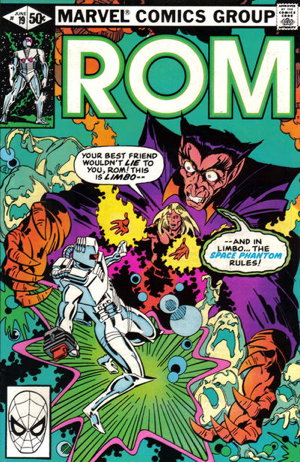 Well, this was as real week for “that’s the last thing I expected to hear”-type news, starting with the stunning return of failed-toy-but-reasonably-successful-comic-character ROM Spaceknight to Marvel Comics!
Well, this was as real week for “that’s the last thing I expected to hear”-type news, starting with the stunning return of failed-toy-but-reasonably-successful-comic-character ROM Spaceknight to Marvel Comics!
Now as far as anyone can tell, this “return” seems to be limited to reprinting the original material, in this case in those large Omnibus editions and at least one facsimile edition in the form of a reprint of issue #1. Also included will be those crossover issues that, previously, had been on the reprint-banned list and skipped over in trade collections for other characters. For example, an issue of Power Man and Iron Fist will be in Omnibus #1. (Which has me wondering…Peter David put an unarmored, totally human ROM in an issue of Incredible Hulk…will this Not Approved by the License Holder appearance get into an omnibus?)
At any rate, this is exciting news, with the license holder apparently discovering with the attempted ROM comics revival at another publisher a few years back that the ROM people want is the Marvel version. And my recommendation…if you want these, get your preorders in as soon as possible and buy them right away. No idea how long Marvel has the license, or under what restrictions (like how often can they reprint these books). I don’t know if waiting for cheaper “Epic” paperback collections would be wise.
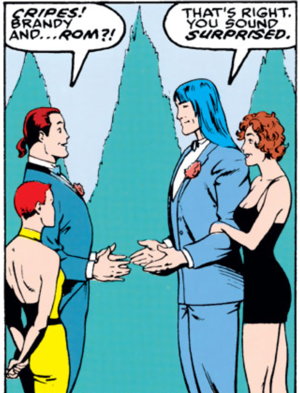 And I don’t know if Marvel would be allowed to reissue some of their other trade collections that previously omitted any ROM appearances. Most notably, there’s an issue of Incredible Hulk that prominently featured the Spaceknight, #296 from 1984, that when reprinted had all of ROM’s appearances in the story replaced with text pieces explaining what happened without mentioning the character by his at that point unlicensed name. Be nice to have that fixed.
And I don’t know if Marvel would be allowed to reissue some of their other trade collections that previously omitted any ROM appearances. Most notably, there’s an issue of Incredible Hulk that prominently featured the Spaceknight, #296 from 1984, that when reprinted had all of ROM’s appearances in the story replaced with text pieces explaining what happened without mentioning the character by his at that point unlicensed name. Be nice to have that fixed.
After the ROM announcement, people responded with “wow, now do the Micronauts,” and lo, Marvel done did the Micronauts. Like ROM, these comics will also be issued in the large Omnibus hardcover format, preceded by a facsimile edition of the initial Micronauts comic book. Most of the comments I made about the ROM reprints above can be applied to the Micronauts as well. Order early, order often!
I don’t think the Micronauts popped up in other Marvel comics as much as ROM did, but there’s at least the X-Men/Micronauts mini-series so hopefully that’ll make it in. Also, it’s actually pretty good.
The third, slightly less surprising news, is Image Comics announcing they’re shifting their distribution to Lunar. I mean, “less surprising” in that I figured another biggish publisher would split from Diamond and move elsewhere eventually, and that Image was one of the likely suspects.
Like with Marvel, Image will still be available through Diamond, but likely at a worse wholesale discount. This is a pretty significant hit to Diamond, I would think, and one I thought would be a fatal blow. But, given that apparently a number of retailers have stuck with Diamond for their Marvel business, despite it costing more, I imagine the same will occur with Image. So, you know, Diamond’s not done yet. But I can picture a day, maybe years from now, when the company will be “Your #1 Source for Sexy Anime Bikini Girl PVC Statues, and Only That!”
It will be nice to have a couple different sources for reorders, in case one of the other is out of stock on something. And the distributor competition has been good for Diamond, in that my shipments are relatively error free compared to, well, the last couple of decades. I know that’s not the case for everyone, as when I mentioned this on the Twitters I heard from another retailer that the missing/damaged books in his shipments have been just as bad, if not worse. As such, I’ll just consider myself lucky, and hope they’re not building up to a shipment where all my boxes are delivered on fire or something.
image from Incredible Hulk #418 (1994) by Peter David, Gary Frank and Cam Smith
« Older Entries























 Well, this was as real week for “that’s the last thing I expected to hear”-type news, starting with the
Well, this was as real week for “that’s the last thing I expected to hear”-type news, starting with the  And I don’t know if Marvel would be allowed to reissue some of their other trade collections that previously omitted any ROM appearances. Most notably, there’s an issue of Incredible Hulk that prominently featured the Spaceknight,
And I don’t know if Marvel would be allowed to reissue some of their other trade collections that previously omitted any ROM appearances. Most notably, there’s an issue of Incredible Hulk that prominently featured the Spaceknight, 